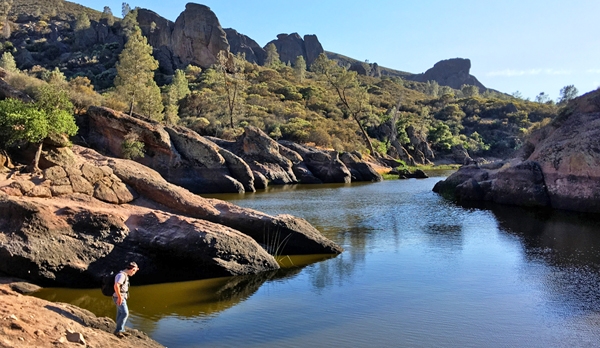
Albert Ruhi is an assistant professor in the Department of Environmental Science, Policy, and Management at UC Berkeley.
You are new to UC Berkeley. Can you tell us a little bit about your background?
Sure! I'm a freshwater ecologist and study how animal communities respond to hydrologic variability and drought. I am from Catalonia, Spain, and studied biology and got my Ph.D. at the University of Girona. During my graduate work, I had the opportunity to visit the University of Georgia and had an incredible time exploring swamps and collecting bugs in Carolina bays. After a short postdoc at the Catalan Institute for Water Research, I came back to the U.S. and started a postdoc at Arizona State University. Finally, just before coming to Berkeley, I was a fellow at the National Socio-Environmental Synthesis Center (SESYNC).
As you can see, I've moved around quite a bit! I feel fortunate to now be growing my research lab group at UC Berkeley and look forward to contributing our research to the pressing water challenges we face in California.
What kinds of questions has your research addressed?
For my graduate research, I studied the ability of restored wetlands to enhance aquatic biodiversity and found that while these wetlands can help, it depends on geographic context and time. In Arizona, I studied the effects of recent hydrologic change on biodiversity in southwestern rivers in the Colorado River basin. And, my work at SESYNC focused on the impact of dams from an applied, policy-relevant perspective.
At this point, I am most interested in understanding when river conditions may be “too novel,” meaning that they've changed or been disrupted by things like dams, for native organisms to persist and thrive. That research is, of course, easier said than done. Species interact with each other and the environment in complex ways that can be hard to tease apart. For example, I recently examined how the effects of flow alteration and invasive species interact to impact native biodiversity. I found interactions do occur, but the effects of hydrologic alteration are often paramount.
Ultimately, I would like to be able to identify habitats that are most valuable for sustaining species at the landscape scale, and should therefore be prioritized for conservation. We need to be able to anticipate how aquatic ecosystems may respond to increasingly variable conditions, and I think freshwater ecologists have an important role to play here. I am trying to contribute by combining field observations with analysis of large data sets. There are so many new opportunities to do this work given the amounts of water data being collected both in situ and from space!
What kind of research will you be pursuing in your new role here in California?
I will be mainly looking at the ecological effects of hydrologic alteration using both fundamental and applied approaches. I am now designing a set of experimental stream channels that I hope to install soon at the UC Angelo Coast Range Reserve. I am so excited about this project because I think it may improve our current understanding of how food webs in small streams respond to different facets of drought including increased frequency, duration, and magnitude.
I also just received funding from the National Science Foundation to continue studying the effects of flow intermittency on stream insects. This is a stimulating collaboration with several other scientists – we hope to get at the ecological effects of hydrologic drought at bigger spatial and temporal scales.
Finally, I want to resume my applied research on wetland restoration. Restoration ecology has come a long way by connecting the practice of ecological restoration with ecological science. However, we still need to fully understand the potential for restoring not just wetland acreage and collections of species, but also the critical connections between species and adjacent ecosystems that allow for complex, “healthy” food webs. I hope to contribute to this knowledge gap by leveraging some remarkable wetland restoration initiatives that are going on in the San Francisco Bay, such as the South Bay Salt Pond Restoration Project.